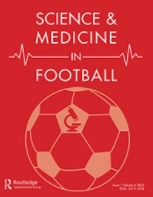Maurizio Fanchini1,2, Ermanno Rampinini3, Marco Riggio1, Aaron Coutts4, Claudio Pecci3, and Alan Mccall5
1, US Sassuolo Football Club (Italy) 2, University of Verona (Italy); 3, MAPEI Sport Research Centre (Italy); 4, University of Technology, Sydney (UTS) (Australia);5, Edinburgh Napier University (United Kingdom)

Purpose: To examine association and prediction of load-based markers (rate of perceived exertion) with non-contact injuries.
Materials and methods: Thirty-four elite Italian football players (age 26 ± 5 y, height 182 ± 5 cm, body mass 78 ± 4 kg) participated in a 3-seasons prospective study. Markers examined were: RPE, exposure, weekly load, week-to-week load change, cumulative 2, 3, 4 WL, acute:chronic 1:2 (acute:chronic2), 1:3 (acute:chronic3) and 1:4 (acute:chronic4) WL ratios. After checking multicollinearity between markers, a Generalized Estimating Equation analysis was used to examine association with a non-contact injury in the subsequent week. The associated markers were split into four groups based on 15th, 50th, 85th percentile to compare injury risk (IR) in different zones. Prediction was examined with receiver operating characteristic curve, area under the curve (AUC) and Youden index.
Results: IR increased when acute:chronic2 of 1.00–1.20, >1.20 were compared to <0.81 (odds ratio (OR), 90% confidence interval (CI): 1.6, 0.79–3.29; 2.2, 1.03–4.74). IR increased when comparing acute:chronic3 of 1.01–1.23, >1.23 vs. <0.80 (OR, 90% CI: 1.9, 0.9–3.8; 2.5, 1.2–5.4). IR increased when comparing acute:chronic4 of 0.78–1.02, 1.02–1.26, >1.26 vs. <0.78 (OR, 90% CI: 2.4, 1.4–3.9; 3.3, 1.6–6.6; 3.5, 1.7–7.4). The AUC ≤0.60 for all markers and Youden Index (close to 0) showed poor prediction.
Conclusion: Acute:chronic markers showed association however with poor prediction ability.
Science and Medicine in Football, 2018 Jan 24. DOI: 10.1080/24733938.2018.1429014